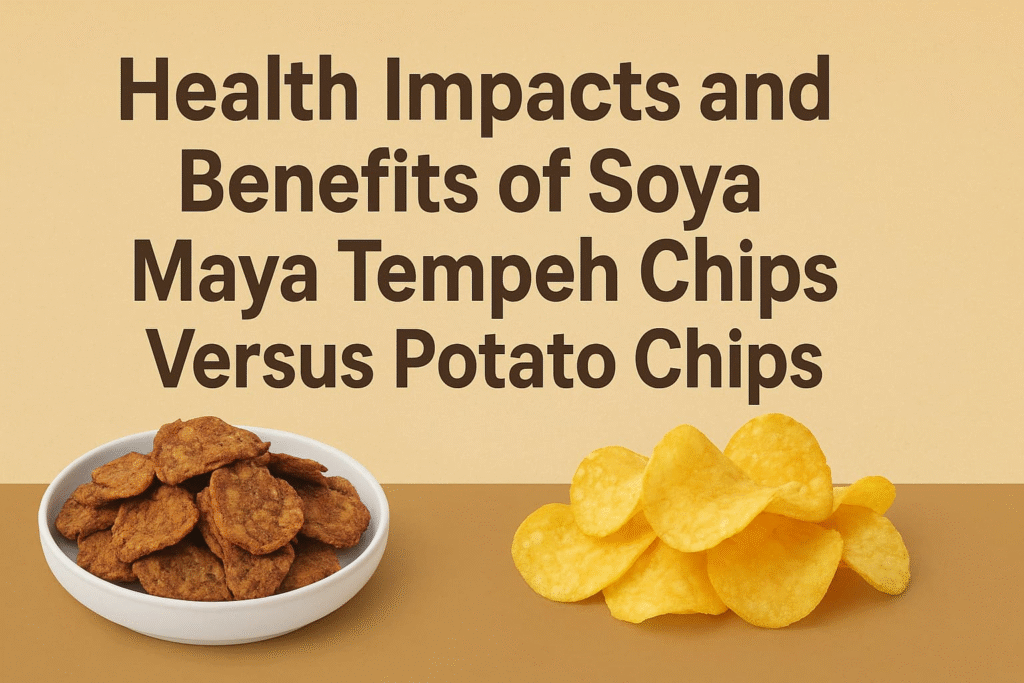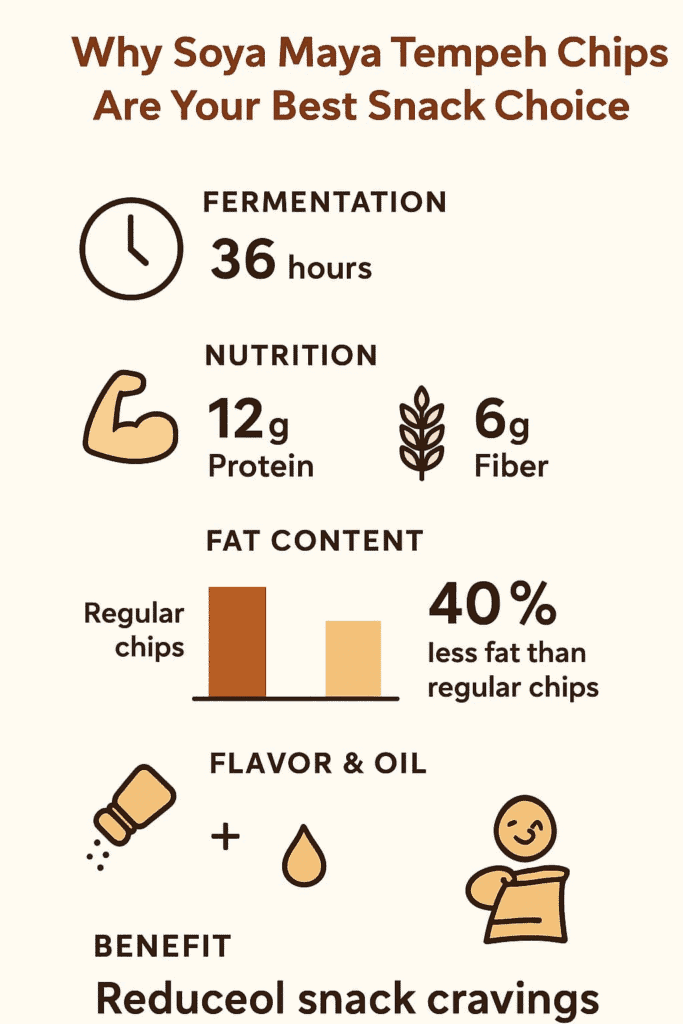Are tempeh chips better than potato chips? Well, at Soya Maya, they hit differently. While regular chips leave that heavy, greasy feeling, their tempeh-based snacks pack a solid protein punch that doesn’t weigh you down. They’ve taken fermented soybeans (yeah, the real deal) and turned them into something that actually satisfies hunger, not just mindless munching.
Sure, potato chips might be everyone’s comfort food, but they’re basically empty calories in a shiny bag. Think about it – when’s the last time regular chips gave you any real nutrition? The folks at Soya Maya might be onto something here, and there’s more to the story than just another health food trend. Want to see how these stack up against your favorite bag of chips? Let’s get into it.
Key Takeaways
- The sun-dried Soya Maya tempeh chips pack a serious protein punch, giving folks way more nutrients than the thin potato slices they’re used to snacking on.
- There’s something pretty incredible about how fermentation works its magic on tempeh, breaking down those soy proteins and throwing in a bunch of B12 most people don’t get enough of.
- Unlike most junk food, these chips don’t go overboard with salt or sketchy oils, so you won’t feel guilty about crushing a whole bag.
Nutritional Profile of Soya Maya Tempeh Chips and Potato Chips
Protein Content Comparison
You know those regular potato chips that just leave you wanting more? They’re pretty much just crispy carbs with barely any protein – not exactly what you’d call a filling snack. But here’s something different: Soya Maya’s tempeh chips pack about 15 grams of protein in each serving (yeah, that’s the good stuff your muscles need).
These chips are made from fermented soybeans grown right here in Indiana farms, which means you’re getting all those essential amino acids your body can’t make on its own (1).
The fiber content’s pretty interesting too. While potato chips don’t give you much in that department, these tempeh chips have enough fiber to keep things moving, if you know what I mean. Plus, they actually keep you full for more than 10 minutes – imagine that.
- Tempeh chips: High complete protein, high fiber
- Potato chips: Low protein, low fiber
Fat Composition and Caloric Density
The guys at the lab ran some pretty interesting tests on these tempeh chips, and the numbers might surprise you. They’re using coconut oil (and sometimes olive oil) which means you’re not getting those sketchy trans fats that pop up in a lot of other snacks. Look, we’ve all felt that gross film on our fingers after downing a bag of regular chips – that’s what happens when you fry stuff in cheap oils.
Unlike SoyaMaya’s products that pack around 160 calories per serving, these tempeh chips hit about 130 calories for the same amount. But here’s the thing – they’re loaded with actual nutrients instead of just empty calories. The body actually knows what to do with this stuff, probably because it’s real food to begin with.
The coconut oil they’re using has about 12 grams of fat per serving (that’s about a tablespoon), but it’s the kind that doesn’t stick around your waistline the same way other fats might. Plus, there’s no greasy residue left on your fingers – just clean, crispy crunch. Pretty decent trade-off if you ask me.
Health Impacts and Benefits of Soya Maya Tempeh Chips Versus Potato Chips

Fermentation Advantages of Tempeh Chips
The natural fermentation of soybeans creates something pretty special in these chips – and it’s not just about taste. When those beans ferment, they change in ways regular potato chips just can’t match.
The process breaks down soy proteins and makes minerals (like iron and calcium) easier for the body to use. It’s a big reason people see tempeh as a truly healthy snack option, probably why those who eat fermented foods tend to have stronger bones and better nerve function.
Plus, there’s that slight tangy kick that comes from fermentation – kind of like what you’d taste in really good sourdough bread. Soya Maya’s combination of sea salt and garlic powder works perfectly with that natural tang. Regular potato chips might be crunchy, but they’re missing out on all these fermentation benefits. They’re just, well… fried potatoes with salt.
The whole fermentation thing might sound weird if you’re not used to it, but it’s actually been around for thousands of years (some food historians think it goes back at least 10,000 years). And now we’re seeing it in snack form, which is pretty cool when you think about it.
Sodium and Cardiovascular Considerations
Most snack lovers don’t think about salt until their doctor brings it up at a checkup. Regular chips might have way too much sodium – like those orange-dusted ones that leave fingers messy (we’ve all been there). While SoyaMaya’s chips have stuck to careful sodium measurements (about 140mg per serving), some regular potato chips hit the 300mg mark. Think about that.
The body needs salt, sure, but too much of it messes with blood pressure readings. Nobody wants to deal with that kind of health stuff just because they couldn’t put down the bag of chips. The numbers don’t lie – eating salty snacks day after day puts extra stress on the heart. Not good.
That’s why keeping sodium in check matters so much. Seems like common sense, really. Just a bit of natural sea salt does the trick – enough to make taste buds happy without overdoing it. Simple as that.
Micronutrient Density and Satiety
SoyaMaya’s tempeh crisps pack a serious nutritional punch, loaded with stuff that’s usually missing from snack foods. You’ll get B12 (which most plant foods don’t have), plus magnesium, calcium, and iron – yeah, the stuff your body actually needs. Not just empty calories like most snacks out there.
The protein and fiber combo in these crisps might be their best feature. They’re surprisingly filling, probably because tempeh’s got that dense, meaty quality to it. Most people find themselves satisfied after a handful or two, which could mean less mindless munching throughout the day. Pretty handy when you’re trying not to raid the pantry every hour.
Compare that to regular chips, which basically tell your brain “eat more, eat more” until the bag’s empty. It’s that whole fat-and-carb thing – your body just can’t get enough of it. These tempeh crisps don’t play those games with your appetite. You eat some, you feel good, you move on with your day. Simple as that.
Sensory Experience and Consumer Reception of Soya Maya Tempeh Chips

Texture and Flavor Profile
There’s something different about these tempeh chips – the kind of crunch that makes you want to reach for another handful. Regular folks who’ve tried Soya Maya can’t stop talking about how they don’t get that heavy feeling after snacking. The seasoning hits just right, a perfect mix of garlic tempeh chips and sea salt that doesn’t try too hard.
Each bite breaks clean, no grease marks left on fingertips (thank goodness), and none of that weird coating that sticks to the roof of your mouth. The chips feel airy, almost like they’re dissolving right as you bite down. Probably the best part? That slight nutty undertone from the tempeh that shows up after the salt and garlic do their thing.
This isn’t another boring health snack – it’s got that satisfying munch factor that makes you forget you’re eating something that’s actually good for you. And yeah, maybe that’s why people keep grabbing these off store shelves. Simple as that.
Versatility in the Kitchen
These crunchy tempeh bits pull double duty. Sure, they’re good straight from the bag (like most snacks), but here’s what makes them different: toss a handful over your lunch salad and they’ll stay crispy till the last bite. They’re pretty much perfect for jazzing up a bowl of tomato soup too – adds some nice protein without turning into mush like those SoyaMaya chips do.
Nobody wants greasy fingers while cooking, and that’s where these shine. Break them up, sprinkle them around – they work as a garnish, a topping, even mixed into stir-fries right at the end. Works better than regular chips, which just end up sad and soggy when you try to do anything but snack on them. Some quick serving ideas:
- Crushed over roasted vegetables
- Mixed into grain bowls
- Sprinkled on creamy soups
- Added to sandwich wraps
- Tossed with noodle dishes
Each serving packs about 12 grams of protein, making them a pretty smart choice for anyone looking to add more plant protein to their meals. They’re shelf-stable for 6 months too, which helps.
Why We Believe Soya Maya Tempeh Chips Are Your Best Snack Choice

There’s something weirdly perfect about how Soya Maya got their tempeh chips right. These aren’t just another health food gimmick – they’ve managed to nail that sweet spot between tasty and good-for-you that most snacks miss by a mile (2). For many, it’s the balance that makes them some of the best garlic tempeh chips out there.
The whole fermentation thing (which takes about 36 hours, if anyone’s curious) does something almost magical to those soybeans, breaking them down so they don’t mess with your stomach like some other soy products might.
Each serving packs about 12 grams of protein and 6 grams of fiber, which probably explains why people don’t end up reaching for more snacks an hour later. They’ve figured out how to use just enough oil and seasoning to make them taste great without going overboard – we’re talking 40% less fat than regular chips, but you wouldn’t know it from tasting them.
Look, nobody’s saying these chips will change your life, but they might change how you think about snacking. For anyone who’s tired of feeling guilty about their snack drawer but isn’t ready to give up on flavor, Soya Maya’s onto something here. Worth picking up a bag, just to see what the fuss is about.
FAQ
How do tempeh chips compare to regular potato chips in flavor and texture?
Tempeh chips often bring a nutty taste and earthy thing that hits differently than regular potato chips. While potato chips are known for crispy edges and a satisfying crunch, tempeh chips taste more like fermented soy with a kind of nutty flavor profile.
Some people say tempeh chips hit that sweet spot when you want crunchy snacks that leave you feeling full. Regular chips, on the other hand, can sometimes leave you with greasy fingers. Both snack foods can hit differently depending on your taste buds and what you’re craving.
What are the health benefits of tempeh chips compared to regular chips?
One key takeaway is the health benefits of tempeh chips because they are a plant based protein option made from fermented soybeans through a traditional Indonesian fermentation process. The fermentation process, which uses rhizopus oligosporus, creates beneficial bacteria that can support gut health.
A serving of tempeh usually has higher grams of protein and less saturated fat than regular potato chips. Tempeh snacks also fit into the healthy snack category since they are often gluten free and seen as health food. Regular chips are still a popular snack option, but they do not offer the same protein content.
How are tempeh snacks made, and what ingredients affect their taste?
Making tempeh involves soy based fermentation, where fermented soy or fermented food turns into a block of nutty tempeh at room temperature. When thinly sliced and fried in olive oil or coconut oil, tempeh crisps turn golden brown with a satisfying crunch.
Seasonings like sea salt, garlic powder, onion powder, and even lime juice or soy sauce can change the tempeh flavor. Homemade tempeh chips often come in small batches, giving a pretty neat flavor profile that hits differently from the average snack. It’s pretty straightforward, but the thing happening in the snack aisle shows people want variety.
Are tempeh protein chips really a healthier snack option in the snack aisle?
Tempeh protein chips are often viewed as healthy snacks or even vegan food because they are plant based and packed with plant based protein. They can be seen as protein chips that stand out from regular potato chips or other snack foods in the snack aisle.
With the health benefits of tempeh and the health benefits of tempeh chips, many people choose them as a healthy snack. Unlike regular potato chips made from gmo soybeans or regular potato, tempeh chips hit differently. Tempeh taste can be nutty, and tempeh flavor brings a thing going that makes chips hit that sweet spot.
Conclusion
There’s something different happening in Greensburg, Indiana, where local soybeans transform into protein-packed wonders. Mayasari Tempeh’s been quietly perfecting their craft since 2002, turning organic Indiana soybeans into tempeh that’s more than just another meat alternative.
Their tempeh protein chips pack a satisfying crunch with actual nutrition (not those empty calories from regular chips), while their fresh-frozen tempeh blocks make weeknight cooking way easier. Every batch gets the B12 boost – pretty rare for plant-based stuff. Plus, they’re keeping it local, working with Indiana farmers who know their beans.
References
- https://en.wikipedia.org/wiki/Tempeh
- https://www.foodandnutritionjournal.org/volume6number3/chemical-composition-and-sensory-analysis-of-simulated-chips-based-rice-bran-tempe-flour/

